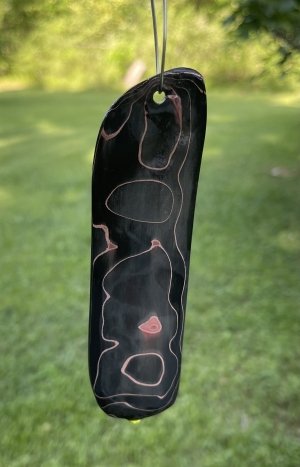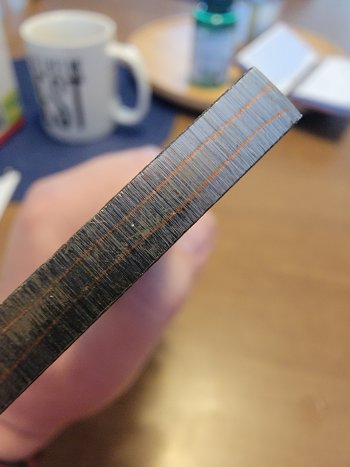You are using an out of date browser. It may not display this or other websites correctly.
You should upgrade or use an alternative browser.
You should upgrade or use an alternative browser.
Cu mai?
- Thread starter jmforge
- Start date
Doug Lester
Well-Known Member
I think it's just to show off something unusual. It's not going to be a usable knife.
Doug
Doug
jmforge
Well-Known Member
I see dealers selling very expensive cu mai kitchen knives. Somebody expects them to cut. I personally have a bit of aversion to putting anything in a blillet that wont harden, even pure nickel.I think it's just to show off something unusual. It's not going to be a usable knife.
Doug
Gliden07
Well-Known Member
I disagree it will be a usable knife as long as you keep the Copper of the cutting edge. I just got done making a billet. 1084 core then 2 layers of copper one on each side then 2 layers of 15n20. I agree it will need more attention than a normal all steel knife especially if you don't want the copper to "Turn". I think it is a cool an relatively new look. I haven't made a knife with it yet trying to decide what I want to make. Don't even know if billets any good yet for that matter!! LOL!!
52 Ford
Well-Known Member
Going back to the Kershaw "composite" blades. 2 types of steel joined by a copper braze joint.I disagree it will be a usable knife as long as you keep the Copper of the cutting edge. I just got done making a billet. 1084 core then 2 layers of copper one on each side then 2 layers of 15n20. I agree it will need more attention than a normal all steel knife especially if you don't want the copper to "Turn". I think it is a cool an relatively new look. I haven't made a knife with it yet trying to decide what I want to make. Don't even know if billets any good yet for that matter!! LOL!!
I still haven't messed around with it in my forge - I need to get on that after I finish my new grinder build (I'm building a new grinder - I used it for the first time last night!
Sent from my Champion Forge using Tapatalk
Edwardshandmadeknives
Well-Known Member
As long as the copper is off the edge, I don’t see how having a layer of copper will make it unusable. HT shouldn’t be affected, as long as you are using steel with an austenizing temperature that is lower than the melting point of the copper. I haven’t used any yet, but I know of several makers that are turning out some pretty nice stuff using Cumai.I think it's just to show off something unusual. It's not going to be a usable knife.
Doug
Edwardshandmadeknives
Well-Known Member
Probably the same logic behind using wrought/HC steel, etc. lots of laminated use non-hardening layers in a composite material. Heck, you can order a titanium/HC san mai even, from Takefu.So what is the logic behind smashing copper, a substance that does not really harden, into a steel blade?
Jesse Latham
Well-Known Member
I have a bowie on the bench waiting for ht with a 1095 core with cu, 17-layer damascus, cu, 17-layer damascus on each side. So, four layers each side of the core.
Gliden07
Well-Known Member
Before I made the Billet I did some research and found out that you have to get copper to almost molten and the shear strenth if done correctly is around 70,000 PSI. Full disclaimer though I've never done it nor have I made a blade yet. I'm debating what I should make. A Chef would be cool but I'm worried about the Copper staining? If you look at the attached pic you can see the Copperon the end of the Billet.
Attachments
The normal Cu San Mai makes as good a blade as can be made since they have a HC core and the copper is only for visual appeal. Here's a knife I did with 26C3 for the core with 1084 for the cladding. The copper acts as a "brazing" agent to hold the cladding to the core.

Here's a copper Damascus I did the other day to see what it would look like. Not sure about a blade, but the wife thinks it would make great jewelry.


Here's a copper Damascus I did the other day to see what it would look like. Not sure about a blade, but the wife thinks it would make great jewelry.

Gliden07
Well-Known Member
Not an expert here so take this with a grain of salt. If the weld/braze between the Copper and other steel is done right (no voids) I don't think it would be a problem because to get corrosion you would need oxygen correct? Good question though have to look a bit further into it!Wouldn't galvanic corrosion be a concern between the copper and steel, especially in a kitchen knife?
I do think they look really cool though
jmforge
Well-Known Member
Hey, I'm just saying that copper went out of style for me as a blade material once I heard about those Hittite cats and their funky iron stuff. I told the Pharaoh that they had found the stuff under ground, so they didn't have to wait for Ra to drop little chunks of it out of the sky. 

Last edited:
jmforge
Well-Known Member
Doesn't mean that I am going to order it from Takefu.Probably the same logic behind using wrought/HC steel, etc. lots of laminated use non-hardening layers in a composite material. Heck, you can order a titanium/HC san mai even, from Takefu.
Edwardshandmadeknives
Well-Known Member
So what reason do you have for not wanting non hardening materials in the blade? Nickel is frequently used to prevent carbon migration in San mai construction, copper would do the same. As long as it’s not a part of the cutting edge, I think that the benefits of sandwiching a hard center layer between two soft layers is pretty well understood. Not saying you are “wrong” by any means, but I guess I always thought that the result would be a stronger blade. Is it a personal preference, or am I missing something there? Just to be clear, I have not used copper laminates, I’m not defending them, I just can’t see why they would be “bad”.
jmforge
Well-Known Member
On the other hand, If you were forge welding some san mai, would you prefer that the layers actually be forge welded together or merely hard soldered/brazed? Note that in a previous post, I said that I am not totally on board with the pure nickel thing.So what reason do you have for not wanting non hardening materials in the blade? Nickel is frequently used to prevent carbon migration in San mai construction, copper would do the same. As long as it’s not a part of the cutting edge, I think that the benefits of sandwiching a hard center layer between two soft layers is pretty well understood. Not saying you are “wrong” by any means, but I guess I always thought that the result would be a stronger blade. Is it a personal preference, or am I missing something there? Just to be clear, I have not used copper laminates, I’m not defending them, I just can’t see why they would be “bad”.
Edwardshandmadeknives
Well-Known Member
When I do use laminated, it’s all forge welded together. For me, I just kind of don’t like the look of the copper. I am not sure that it would be weaker than a traditional laminated blade though. For the people who are using it, I don’t see any reason why a blade from it would necessarily be less useable than any other methods. It would be kind of interesting to see a Charpy comparison between a cu mai and monosteel sample, or traditional San mai. Despite the fact that the layers are basically brazed together, I wouldn’t be too surprised if the cu mai was actually tougher. Just kinda wondering - has anyone here broken a sample of it? Do the layers separate at the copper, or does it break more like a traditional San mai blade?


